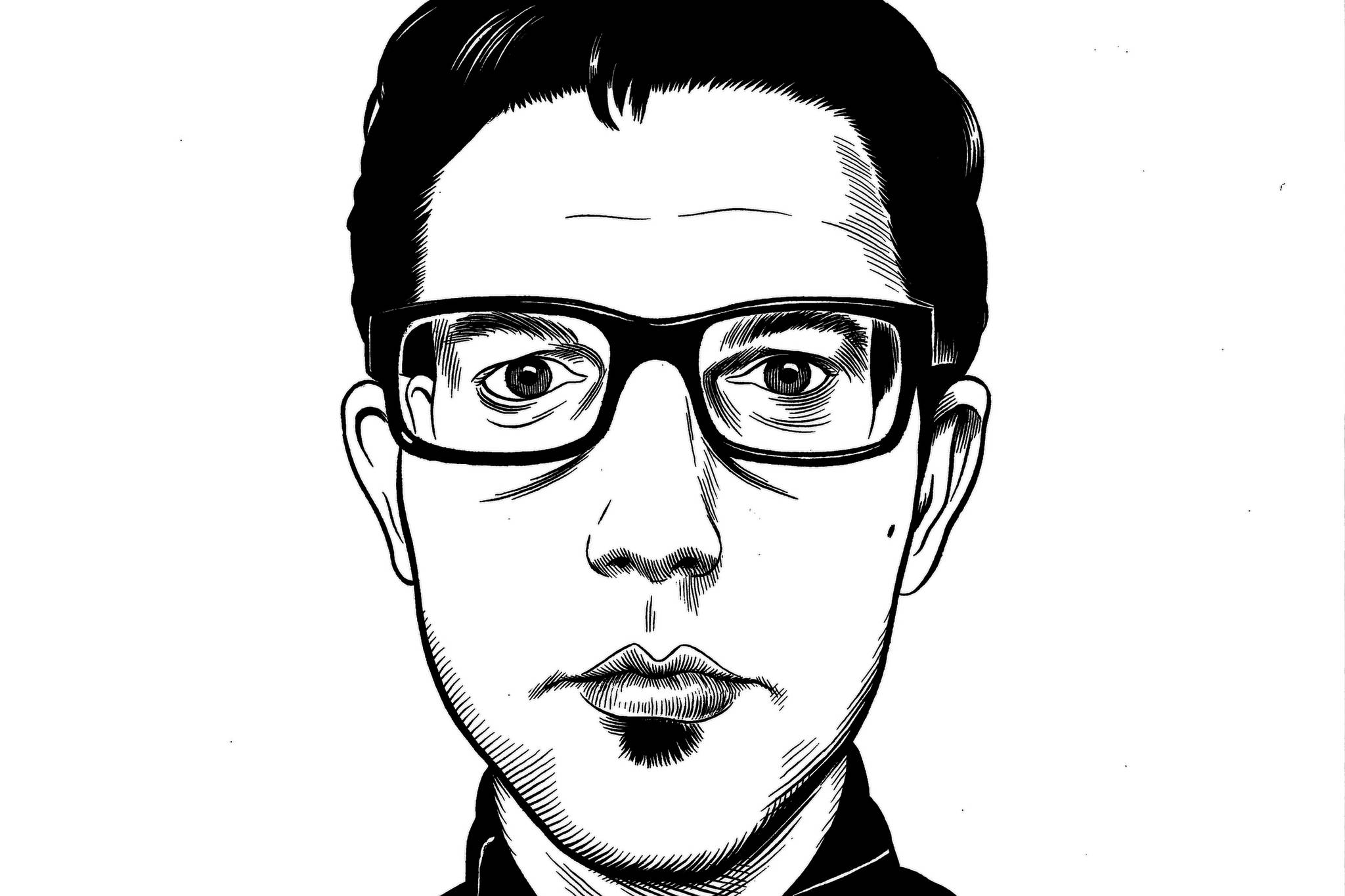“Comics readers are conditioned by other media and the ‘real time’ of everyday life to expect a very linear progression,” Scott McCloud declared in his classic treatise on the medium, Understanding Comics. But as McCloud deftly illustrated, “time in comics is infinitely weirder than that.”
In D.J. Bryant’s debut Fantagraphics collection, Unreal City (out now), time rarely flows in one direction. In nearly all five bizarre short stories in the Seattle artist’s new book, narratives bunch up, loop back on themselves, or end where they began. A classic “THE END” might wrap up one story; in the next, “THE END” will be written backward; in another you find an even more circuitous “THE END BEFORE THE BEGINNING…” In “The Yellowknife Retrospective,” a man named Jack enters a gallery whose architecture happens to incorporate “temporal design.” As Jack runs around the dome-shaped building, he encounters past and future versions of himself. “Holy shit! That’s us from just moments before!” Jack exclaims from the bottom of the page, pointing up at a “previous” panel.
In person, Bryant is so casual about his stories’ gleefully serpentine nature that I wonder how he himself experiences time. “It’s just a natural way of telling a story to me,” he says. “It just seems to be such a fundamental principle. You know, you’ve got the Earth in rotation, day becomes night becomes day again. The cycle of death and rebirth.”
 Bryant’s self-portrait.
Bryant’s self-portrait.
Cartooning is a fairly lonesome art, but Seattle’s comics scene is more social than most. Café Racer’s regular Dune drawing night, the Short Run festival, the Exterminator City market, and collaborative newsprint anthologies like Thick as Thieves bring Seattle artists together. Despite this, and though he has now been published by one of the country’s most prestigious presses, most local comics artists and fans have likely never heard of Bryant. There’s a reason: He dropped out of time for seven years, quietly realizing the anxiety-riddled fever dreams that make up Unreal City. “I’m definitely guilty of being in my cave,” he says. “The way I write is almost the exact opposite of the way I draw. I write very very fast, as intuitively as possible. It’s a very weird, abstract thing that comes out. Part of the fun of it is taking this weird thing that came out that’s so nebulous, crafting it very meticulously, and carving it out of these very fine, sharp lines. But it takes a very long time to do it.”
Bryant’s presence in the scene may be new, but those fine, sharp lines will look very familiar to long-time Fantagraphics and Northwest alt-comix fans. Visually, Bryant’s style sits at the intersection of Daniel Clowes’ and Charles Burns’. “It’s pretty obvious,” Bryant says. His work is no hack job, though. Narratively, the closest his stories come to those of those forebears is at their most surreal–a leap off the hallucinatory cliffs of A Velvet Glove Cast in Iron and the X’ed Out trilogy and into some murkier, more disturbing void.
That darkness is no coincidence. Bryant began the first Unreal City story, “Evelyn Dalton-Hoyt,” back in 2010. In the tale, based on Steve Ditko’s 1972 comic “Driven to Destruction,” the marriage of Evelyn, a sex therapist, and a man named Henry is rapidly deteriorating. The story is full of graphically rendered penises, breasts, and vulvas, but the context is rarely sensual. Instead, the sex is fraught with anger, derision, and mania. An unwanted highway hand job begins the story, promptly ending a page later in a car crash. The line between love and hate gets thinner and thinner, and soon Henry begins dreaming of a world without Evelyn, a dream he eventually tries to act on.
“I didn’t think there was a connection between ‘Evelyn’ and my marriage,” Bryant says. “I should’ve realized it, but I didn’t. A few weeks after I finished with ‘Evelyn,’ my whole marriage fell apart. All the stories in Unreal City are relationship stories, but they all deal with the anxieties of relationships. None of them are happy romances… . ‘Emordana’ came out of the loneliness of the post-divorce period. I felt like a different person after I finished ‘Emordana,’ and I feel like a different person now that I’ve finished the book.”

Feeling “like a different person” is a sensation the prevails throughout Unreal City. Beyond loopy narratives and relationship anxieties, these tales are also bound by the blurry, shifting lines that compose one’s identity. In “Objet D’Art,” a comic artist named Leon starts obsessively drawing a femme-fatale character named Blanca Lagos, who is modeled after a character created by Leon’s favorite artist Lucien Lofficier. Leon’s wife, lonely due to her distant, workaholic husband, manages to regain his time and attention by dressing up like his creation, complete with leather rabbit ears and a Zorro mask. As Blanca, she later attracts a different man’s attention, who by the end of the story has also morphed into a different person altogether.
This particular thematic element gets a boost thanks to one of Bryant’s cartooning quirks: his use of recurring “cartoon actors.” “I’ll repurpose these same figures in different roles from story to story,” Bryant says. “It’s an idea I pulled from film—I noticed a lot of my favorite directors used the same actors, like Scorsese and De Niro. In one Scorsese film, De Niro would be a gangster, and in the next he’d play a comedian. Cartooning-wise, it’s nice, because you really learn how to draw these ‘actors,’ and as you get more comfortable with them, you get better performances out of them.” While he initially drew the idea from film, Bryant would later discover that pioneering manga master Osamu Tezuka employed a similar method.
Bryant’s cartoon actor “Johnny” (although he’s never referred to as such in the book) makes an appearance in two paranoia-filled stories. While he retains the same facial structure, darkened brow, and sullen Humphrey Bogart eyes throughout, in the latter story he sports a thin mustache. The stories are spaced out enough that you might not catch this at first, but when you do make the connection, the collection’s merging and disintegrating webs of identities become even more tangled and confounded.
“The world is inherently surreal,” Bryant says. “We’re kind of born into the middle of this story we didn’t start, and we can never get the full picture, and we go out before the picture is finished. Our whole lives are just kind of this one mystery puzzle piece. Even if Unreal City is a really dark book, I hope it’s positive for people and helps them get a handle on our human anxieties, because it definitely helped me.”
Like McCloud says, time in comics is “infinitely weirder” than the “ ‘real time’ of everyday life.” But then again, everyday life in 2017 seems to be getting infinitely weirder each day. As much as Unreal City might make you scratch your head, the surreal stories within it grasp at something very real. Unreal City Book Launch and Art Exhibition. Fantagraphics Bookstore, 1201 S. Vale St. Free. All ages. 6–9 p.m. Sat., Sept. 9.
ksears@seattleweekly.com








